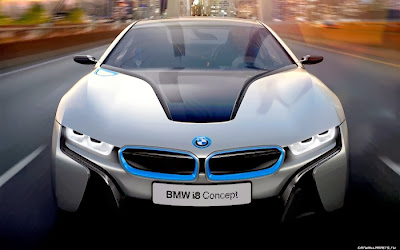A global successful car maker within the premium segment comes out with a new technology for the headlights. When we speak about headlights, the car that will flash through our eyes will be BMW. Yes, it this prince who is going to bring a spectacular concept in the development of headlights.
Introduction of the full LED headlights always went ahead looking for the next logical step in the development of vehicle headlights. And now BMW has come up with an effective innovative technology and its source is a blue-laser diode which is 1000 times as bright as an LED but uses just two-thirds the energy.
The idea came up within three BMW's brightest lights. They are Project founder Volker Levering, who laser inspiration-a mental bulb, if you will-flashes on during a 2010 Christmas ski trip in the Alps, Stefan Weber, the current program leader and Helmunt Erdl. "A person may not directly aware, but you can instantly feel the difference between good and bad light," says Weber, as he switches on a wall of fluorescent panels. Panels stimulate a sunny day above ground, right up to the 6500-kelvin colour temperature that photographers consider natural daylight. And guess what, BMW's system will deliver about 5500-6000 K- the highest colour temperature that international regulations will allow.
Until the dawn of semiconductor lighting, the whitest brights any headlights could manage mere high-intensity discharge (HID) also know as xenon lamps, which BMW introduced on the 1991 7Series coupe. HID light is still an optional for today's cars as well, but its weaker ,yellower and less energy efficient than either LED or laser light.
The first LED headlights shone from a car a mere six years ago, when Lexus introduced them on its LS600h L sedan. Soon, the technological torch may pass to lasers. Laser light will debut in Europe in the 2014 BMW i8, a plug-in hybrid sports car that promises 2.45 litres per 100 kilometres and a 4.4 second surge from 0 to 100 kilometres per hour.
 |
BMW engineers are currently working on the it which will be in series production soon. By definition, laser lighting is radically different from sunlight and also the various types of artificial lighting in common use today. For a start, laser lighting is monochromatic, which means that the light waves all have the same length. And it is also what is know as a "coherent" light source, which means that its waves have a constant phase difference. As a result, laser lighting can produce a near parallel beam with an intensity a thousand times higher than conventional LEDs. In vehicle headlights, these characteristics can be used to implement entirely new functions. Also, the high inherent efficiency of laser lighting means that laser headlights have less than half the energy consumption of LED headlights. Simply put, laser headlights can save fuel.
The intensity of laser light posses no possible risks to humans, animals or wildlife when used in car lighting. Amongst other things, this is because the light is not emitted directly, but is first converted into a form that is suitable for use in toad traffic. The resulting light is very bright and white. It is also very pleasant to the eye and has a very low energy consumption.
BMW always aims at some advantages that are purely visible and noticeable. With a length of just ten microns, laser diodes are one hundred times smaller even than the small, square-shaped cells used in conventional LED lighting. This opens up all sorts of new possibilities when integrating the light source, although that would be theoretically possible. Also note that, it can play an important role in new headlight positioning and body styling. Another important advantage that BMW engineers intent to use is high inherent efficiency. A single statistic will make this clear. LED lighting generates only around 100 lumens per watt and laser lighting generates about 170 lumens. Now we can see why they took a step more into laser technology.
One more important aspect that BMW take into account is safety. For BMW, the complete eye safety of this technology for all road users and its complete reliability in day-today use have top priority. Importantly, therefore, before the light from tiny laser diodes is emitted onto road, the originally bluish laser light beam is first of all converted by means of a fluorescent phosphor material inside the headlight into a pure white light which is very bright and pleasant to the eye. As a result, in future it will be possible to use laser light to implement all the familiar -including more recent-BMW lighting functions such as Adaptive Headlights, the "Dynamic Light Spot" spot lighting system and the "Anti-Dizzle High-Beam Assist". It will also help them to implement new functions that uses very less power consumption.
Cant wait to see them on the road. :) :D




No comments:
Post a Comment
If anyone has any other questions or requests for future posts,how to posts, you can ask me in comments or email me. Please don't feel shy at all!
I'm certainly not an expert, but I'll try my hardest to explain what I do know and research what I don't know. I would love to hear your thoughts! Be sure to check back again. I would certainly reply to your comments :)